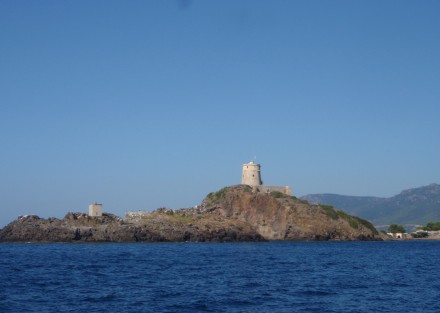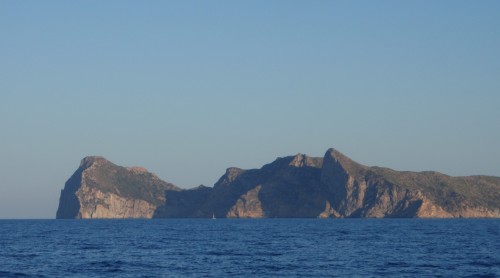SARDINIA
Our trip from Sicily to Sardinia was an uneventful and boring passage. We traveled 284 miles in 54 hours (an average of 5.46 mph), and we motorsailed more than 90% of the time. We were out for three days and two nights.
There were two small low pressure systems to the west, and they appeared to be joining forces. We decided to get to Sardinia as quickly as feasible and await another weather window.
Our first night out had big and bumpy seas. Nita got airborne above her bunk twice. The lee cloth prevented her from falling out, but it made sleeping quite difficult.
The winds were calmer the next day, and we even sailed a bit. But they became too calm during the night, and we motorsailed again.
We did not catch a fish on this passage despite throwing in a line on our last morning. We also took no pictures. Just putting on the miles…
We went to Marina di Villasimius on the southeast corner of Sardinia. We would again wait for weather to move on.
The earliest known inhabitants of Sardinia were the Nuraghese around 1500 BC. They were followed by the Phoenicians then the Romans in 238 BC. After the decline of the Roman Empire, Sardinia was ravaged by the Vandals, Byzantines, Saracens, and Arabs. Eventually order was reestablished under the Pisans and later the Aragonese and Spanish.
In the early 18th century, Sardinia was ceded to Austria, but it shortly thereafter became a part of Italy, and in 1948 Sardinia was granted political autonomy. In the 1960s the Aga Khan began developing the Costa Smeralda, and other international developers have followed. Nonetheless, development is mostly restricted to the northeast, and much of the island remains undeveloped.
Sardinia is the second largest island in the Mediterranean – smaller than only Sicily. It has an area of 9,300 square miles and a coastline of 1,150 miles. It has a mountain range running north-to-south with a peak elevation of more than 6,000’. Sardinia is more than 100 miles from the Italian mainland. Its population is approximately 1.5 million.
We moved along Sardinia’s south coast quite quickly. We made only three stops.
We again went in to a marina to clean the boat and wait for a weather window. We quickly realized that the marina in Marina di Villasimius offered little more.
The marina charged us 90 Euros (the equivalent of approximately $112.50 USD) per night to tie up there. That is about the going rate this time of year in this area. Then they had the audacity to put a coin meter on the shower – yes, charging for a shower after paying their exorbitant rates. We showered on board. We decided that we did not like this place. But we did get the boat cleaned up and ran the air conditioning for a bit – what a luxury.
We kept busy getting ourselves and the boat ready to travel. Nita did lots of cooking and cleaning. Bud did some boat projects. Because we have been motoring so much, we decided to buy one more gallon of oil to carry with us. We paid $50 USD for a gallon of oil! We are quite weary of being overcharged for everything.

Capo di Pula
We were very close to leaving Italy for Spain’s Balearic Islands, and we still had not found a cruising guide for them. We had been looking since we made our change of plans in Greece, but we could not find it in any stores. Bud had met some Italians on a boat on our dock, and he knew that they had sailed through the Balearics, so he approached them about buying their book. He wanted to pay full price for the book so that they could replace it, but they insisted on giving it to us. They have no idea how much grief they saved us! Since they would not take our money, we did give them our cruising guide for Greece. They are going there next season. We also had them over for a beer and lots of shared conversation. What started out as a functional pursuit ended in a few new friendships.
After two nights in the marina, we left for Porto di Mafalga on the southwest corner of Sardinia. We thought we would probably spend the night there before heading for Spain. But southeasterly winds made this a bumpy trip, so we changed course and headed for Capo di Pula. We motorsailed 25 miles in 5 ½ hours.
We expected this to be an empty anchorage, but there were eleven boats there when we arrived. There is a cape that provides some protection from the southeast, so we decided to spend the night.
The ancient city of Nora is on the cape. This is a Roman city that has mostly submerged below the water. More accurately, sea level has risen to flood most of the city. The city includes a sewer system, a temple to Tanit, and mosaics on the floors of some villas. We could see the ruins from the boat, but we stayed on board. We went on to Porto di Mafalga the next morning.
We motorsailed 15 miles in 2 ½ hours. We both marveled at what a beautiful coast this would be if not for the air pollution. However, there is a thick haze that obscures much of the scenery here.
Porto di Mafalga was a pretty bay. It was very shallow, but we found some sand in 25 feet. It provided good protection from the seas even if not from the wind. We spent a quiet night and finally headed for Spain the next morning.

Dramatic coastline approaching Porto di Mafalga
We know that we are leaving Sardinia without seeing its ‘crown jewel’ – Costa Smeralda on the northeast corner.However, we also know that it is extremely crowded up there right now, and there have been frequent gales around there. We decided that our increasing intolerance of crowded anchorages is greater than our desire to see another pretty anchorage. For now, we are off to Spain!
Sail with us from Italy to Spain or jump ahead to Spain.